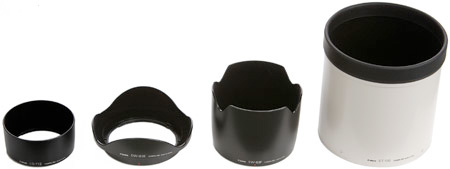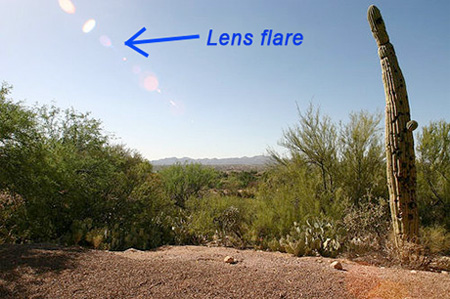“What’s that weird thing on the front of your lens?” This is something I hear every time I teach a photo workshop. Well, you canʼt blame the students. They’re usually beginners, and since we were all beginners once, I try to cut them some slack.

Various lens hoods
Lens hoods or lens shades are a vital piece of camera equipment that you must have on all lenses. Why? Because its main purpose is to prevent lens flare, which happens when you point your lens toward the sun at just the right angle. It looks like a series of translucent rings. Sometimes you’re able to see them through your eye piece and are able to change your angle, but most of the time they appear unexpectedly—and they arenʼt easy to Photoshop out.
A lens hood keeps the light from entering the lens from the sides and degrading the quality of your image. It helps improve the saturation, color, contrast, and density of the photograph.
Why do I have so many students come to class with “naked lenses”? The reason is simple—they arenʼt told that a lens hood is an essential piece of camera hardware for the production of quality images.
Lens hoods are also good protection for the front of the lens, keeping it safe from damage and fingerprints. The tulip shaped lens hoods are used on zoom lenses to accommodate the many focal lengths of the lens. Lens shades for fixed focal length lenses are not tulip shaped.

An example of lens flare
There are many different lens hoods produced by third party manufactures, which are less expensive than brand name equipment. They can be made out of plastic, metal, or rubber. Rubber lens hoods are ideal, because theyʼre best for shooting through glass; the rubber may adhere directly to the glass without slipping and thus reduce reflections. As an added bonus, rubber lens hoods can collapse to take up less room in a camera bag.
The most important thing to remember when buying a lens shade is to find one to correspond to your lens’ focal length. An incorrectly matched shade will produce “cut off” on the corners of your image, which is just as bad as lens flare, if not worse. The rim of the shade contains the necessary information for matching it to the lens. The shade will list the circumference of the corresponding lens in millimeters, and it will also show the focal length of the lens which the shade was designed to be used on.
Why some manufactures donʼt include a lens shade with the purchase of a new lens is beyond me, but what I find even more startling is that camera stores that donʼt recommend lens shades to their customers. Itʼs no wonder so many people fail to realize the necessity of this equipment. I personally have lens hoods or shades for all of my lenses and use them whether Iʼm photographing indoors or outdoors.

How light slips through the sides of the lens without a lens hood.
If youʼd like to improve the quality of your images, I highly recommend that you buy a shade for all of your lenses.
About the Author:
Brian Leng (calphotoworkshops) is a photography educator at Santa Monica College, Pasadena City College, and Glendale Community College. He leads photography workshops around the downtown Los Angeles area and hosts overnight workshops in many locations in the Southwest. He is a graduate of Brooks Institute of Photography and has worked as a freelance photographer in Los Angeles for over 30 years.
Like This Article?
Don't Miss The Next One!
Join over 100,000 photographers of all experience levels who receive our free photography tips and articles to stay current:






I don’t leave home without ’em! My problem — for which I would gratefully accept any advice — is that some lens hoods don’t seem to pair well with various filters. Depending on what lens and what filter and what hood I use, the hood comes loose and falls off. Some combinations work fine, others don’t. Almost like I have to have a variety — such-and-such lens hood pairs with my 18-55 and my 52mm grad ND, but if I switch to my 52mm polarizer on the same lens, I have to switch to my so-and-so lens hood because the such-and-such hood comes off too easily.
Confused? So am I!
To Gregory Stanphill: I had a very similar experience at a waterfall in Oregon: did a face-plant on the trail and tumbled around until I fetched up against a guardrail post. Needless to say the lens hood looked worse than my face! Also got a huge scratch on the clear glass protective filter (another simple and oft-overlooked safety step). Lens itself is still going strong. That was 4 years ago when I was 70. I still shoot, and still hike, and really wish there was a lens hood for the human body!!!
(BTW, Valley of Fire is awesome and I hope to return someday soon.)
Hope you are better after the fall. I know about those as at 77 just a month + ago I crashed and had to worry about damage to my pace maker. Was ok but some pain for a few days. No camera damage. Retired for 20 years as a pro photographer and instructor.
Two must haves — lens shade and camera strap. In 2013 on a boat in China my wife, age 79, fell and the lens shade got a crack in it but lens was fine.
Once on a trip I watched a chap walking along the sidewalk with a lens strap but not around his neck where it belongs (I tend to use hand straps now with my Fuji XT20 due to lighter weight and after awhile a neck strap can become bothersome) and as he walked along and I was watching, he was going to pass a fire hydrant. Well, you likely guessed it. Yup, camera strap was grabbed by the hydrant, out of his hand and crash, broken lens and camera. Wear the neck strap please.
AGM — check out this link https://petapixel.com/2020/06/04/why-uv-filters-are-basically-useless-on-modern-cameras/
UV filters are basically useless with digital sensors but are a great money maker for camera sales folk. For film yes but even then I seldom used on on my Hassy lenses. Some friends did but they were very expensive ones. The times I might have used one was when I would be applying a device like tape or material for diffusion so that the lens was not damaged.
So skip the filter but be sure to use a lens shade on all lenses and a hand or neck strap. Forget about the lens cap unless just storing the lens without the lens shade attached so as to not accidentally adding a scratch to the lens.
just thought I would add this for folks that do not use a lens hood. I always have my lens hood on every lens I am using. A lens hood is also great for protecting the lens. The other day I went to the Valley of Fire and I am 65 yrs. old and have issues with my spine and nerve damage that goes down my right leg. I was walking up an area where there are good sized boulders and rocks. I have my camera and my 70-200mm f/2.8 lens attached. I tripped and on the way down, I dropped my tripod and then gravity took over. Since my camera was on a strap around my neck, as I was going down, the camera was out in front of me and hit the ground/rocks before I did. As the front of the lens hit the ground and my upper followed and the camera was shoved into my left rib cage. As a result, a nice size of the hood broke off and I had a several rib bruise. Yes my hood broke but I collected the piece and when I got home, I was able to super glue it back together. My lens and camera did not sustain any damage besides the hood. My situation should be enough to teach people to keep the hoods on and just reverse them for storage.
Lens hoods are typically not included with lower priced lenses since they are far more profitable to sell as accessories. Plus, most amateurs would not normally consider them important.
Like lens caps, lens hoods (predominantly plastic, with some lined with a felt material) are ridiculously over-priced. People shopping for better costs, can simply visit the lens manufacturer web site, acquire the recommended lens hood and then visit Amazon (searching using the recc hood #) to look through the much cheaper options. Doing a Google search on ‘best replacement for…” will likely yield some results too.
Remember that the lens hood is also great for protecting the front of the lens. In many cases just hang the front of the lens down and you won’t need to keep a lens cap on while you’re looking for shots. As well, there are lens hood covers that work great too to protect the lens element from dust.
And be sure to put a quality UV filter on the front of your lenses…always..
You made a few errors. You said that “Why manufactures donʼt include a lens shade with the purchase of a new lens is beyond me”. Well, every lens I ever bought or traded, new or used has come with a lens shade.
You also said that “The tulip shaped lens hoods are used on zoom lenses to accommodate the many focal lengths of the lens. Lens shades for fixed focal length lenses are not tulip shaped.”. I don’t find this to be true. I have them both ways.
Two of my lens came with a hood but I never used them because did not have an idea the purpose for it. Now, thank to this article, I will try to use them.
I take alot of photos of kids and toddlers. More than once the lens hood has saved my camera rig from flying baby food! LOL! True story. And in a pinch they’re great for holding DIY Colored gells…
Lens hoods are so key when taking great shots. Very informative post.
One other thing that should be mentioned: Sometimes a lens hood can get in the way by blocking light when using on-camera flash with a long lens & hood.
I have a Canon EOS 450D & I have 2 lenses = 1 x 18-55 + 55-250. I would like to know what sort of lens hood I should get. which is better for which lens… a flower/petal hood or a full hood? can someone please help me.
Nice article. I agree that a lens hood should be used at all times, mostly because it protects the front element without sacrificing image quality (unlike flare-inducing UV filters).
Just one correction though:
“Lens shades for fixed focal length lenses are not tulip shaped”
http://media.photobucket.com/image/canon%20ew-63ii/eoa05/IMG_0123.jpg
Almost all wide-angle lenses, zooms and primes, have flower shaped hoods.